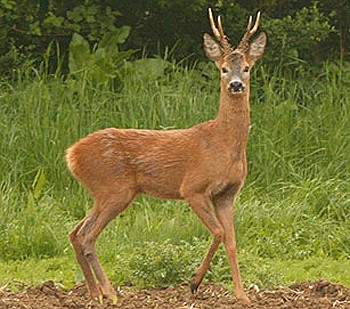Scottish Roe Review 2010

The 2010 season has once again been a busy period for the Scottish arm of the CIC?s UK trophy measuring team. In all, 270 Scottish roe trophies were presented for judging. Of these, 213 achieved medal status and 51 were awarded gold medals. The accompanying medal table (right and overleaf) shows that the majority of these came from those parts of the country that have produced a consistent crop of high-scoring animals over the seasons, but, as always, surprises turn up from less favoured areas. This past year, two close to the top of the table came from the smallest county in Scotland, Clackmannanshire, one with a score of 157.28 CIC points for W. Cottrell and the other, a malformed nine-pointer achieving 147.38 CIC points when presented by its owner, Brian Haddow.
The annual gold medal table is presented in a slightly different format this year. Whereas in previous years the trophies have been listed in length order,
for 2010 they appear in order of the final score achieved. This is in response to comments made to us by stalkers who felt that the top score, rather than the longest head, should lead the table. Five heads scored in excess of 160 CIC points, with the top-scoring head belonging to Mr C. Ruge, who achieved 184.25 CIC points, thus confirming that Scotland continues to produce roe trophies of a high international standard. The irrepressible John Waters just failed to make the top five, with a trophy scoring 159.85 CIC points, which he took in Fife.
As Scottish roe stalkers will recall, 2010 started with a period of considerable snow. This caused a number of dire predictions to be made regarding likely roe mortality, as well as concerns about the probable impact of very cold weather on bucks in the growth phase of their antlers. Though there were some reports of estates recording a reduction of up to 10 per cent in their anticipated cull during February, however, a number of regular stalkers commented on the ability of their deer populations to adapt quickly to poor climactic conditions. Unlike previous years, we did not receive many reports of early cleaning of velvet. If anything, the number of trophies presented showing frostbitten antlers and/or damage in velvet was lower than normal.
Scottish Roe Review 2010 page 1
The number of multi-point heads achieving gold medals was down this season ? four with eight or more points were judged. The most notable of these was an 11-pointer from Mr D. Stewart, from Angus. This trophy scored an impressive 169 CIC points. At the other end of the scale, Dave Lumsden harvested a huge four-pointer in Fife, which tipped the scales at 608g full-skull and scored 155.48 CIC points.
As interest in having trophies judged has grown, the age profile of the heads presented is beginning to change. A quick analysis of this season indicates that around 40 per cent are classed as middleaged, 53 per cent as late middle-aged, two per cent as old and the remaining five per cent as young. In particular, there are significantly more middle-aged heads appearing towards the lower end of the table, which may be due to a number of factors, ranging from the selection criteria being applied by stalkers and guides at the point of harvesting, to the access individual animals have to high-protein food sources. As is the norm, a number of light heads were judged as gold medals, including two with a net scoring weight of 402g and one taken by Mr P. Craig, with a scoring weight of 422g. Its final score of 140.38 CIC points was aided by a scoring volume of 234cc.
Scottish Roe Review 2010 page 2
Seventy-nine trophies achieved silver medals and 83, bronze. These categories always turn up some fantastic trophies and have among them some terrific malforms, which act as a magnet to roe enthusiasts at game fairs and have judges scratching their heads and conferring with each other. In this year?s record, the name R. Gordon appears three times in the silver medal table, once in the middle and once at the top, with a trophy scoring 129.78 CIC points missing a gold by 0.22 of a point. He also appears once at the bottom, with an eight-point head achieving the minimum required score for a silver medal of 115 CIC points. While the tables remain dominated by male stalkers, more women seem to be taking up the sport ? Angela Burgoyne recorded a silver medal at 118.5 CIC points this year.
Mention has been made before over the question of whether or not to cut the trophy prior to judging. Our advice on this has been consistent over the years ? present the trophy full-skulled if the measuring formulae has a weight element (and the one used for roe deer does). This entails more preparation work, but it results in the trophy gaining maximum benefit from the weight element and removes any guesswork about the amount that will be deducted.
For 2011, a CIC qualified and accredited team will be in attendance at The Scottish Game Fair, at Scone Palace, in Perthshire, and the Highland Field Sports Fair, at Moy estate, in Inverness-shire. While demand for our service is always strong at these events, we are more than happy to ensure that you can see your trophy being judged and to explain the scoring process with you.
We look forward to seeing you over the coming season and wish you good stalking.
With thanks to Steve Todd, Alisdair Troup, Tony Dalby-Welsh, Charles Fenn, Barry Martin and Richard Prior for their help in compiling the records. For details of the silver and bronze heads, visit www.shootingtimes.co.uk.








